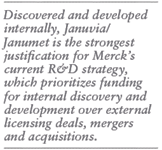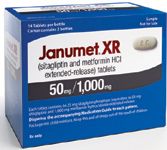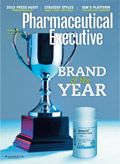Brand of the Year: Januvia
In 2012, Merck's diabetes franchise became the highest-selling product family in its 122-year history.
The problem with uncontrolled diabetes is that it doesn't hurt right away. That's good and bad. It's good in that most patients don't initially experience pain associated with adult-onset Type 2 diabetes, the most common form of the disease. Like high cholesterol levels, the symptoms associated with high blood glucose levels usually aren't manifest in patients at first. And when the telltale symptoms of diabetes do emerge—fatigue, hunger, excessive thirst, and a resulting increase in trips to the restroom—they are easily overlooked or ignored entirely.

(Getty Images / Tom and Steve)
This is bad because it minimizes the incentive to see a doctor. Seeing a doctor can require time off work. Once diagnosed, the prescriptions cost money, which is especially hard for seniors on fixed incomes. These factors work against the critical importance of maintaining stable blood glucose levels. Failure to maintain the proper blood glucose levels over time will almost certainly lead to severe, if not life-threatening complications. These debilitating and enormously expensive complications, include, but are not limited to, heart disease, neuropathy and amputation, skin disorders, impotence, coma, and death. The cost of diabetes in the United States alone, including direct medical costs and indirect costs related to disability, work loss, and premature mortality, was approximately $174 billion in 2011, according to a joint report from the American Diabetes Association, CDC, and NIH. Diabetes is also the leading cause of kidney failure and new cases of blindness in the United States.
But nothing really happens if a Type 2 diabetic decides to substitute his medication for a couple of pixy sticks and a cigarette on any given day. In less developed nations, the decision to forego medication may seem more like a necessity than a choice; if a patient with diabetes isn't visibly sick, shouldn't a family's limited resources be devoted to more urgent needs? According to the World Health Organization (WHO), 347 million people worldwide have diabetes, 90 percent of which have Type 2 diabetes. In 2004 roughly 3.4 million died as a direct consequence of the disease. Over 80 percent of those deaths occurred in low and middle-income countries. The WHO expects diabetes-related deaths worldwide to increase by two-thirds between 2008 and 2030. In the United States, 24 million people had diabetes in 2009, and that number will nearly double by 2034, according to NIH projections.

Top 10 Countries for People with Diabetes
While diabetes isn't contagious, the staggering increase in worldwide incidence of the disease in recent decades has been referred to as a pandemic, with all of the hair-raising urgency that term connotes. The concern is justified, but the problem remains: as economies in developing countries continue the transition from labor-intensive industries to the mechanized, information-age sedentariness of office life—salted with the fatty, carbohydrate-laden foodstuffs proffered by western food chains that almost always accompany this transition—how can the life sciences industry help to stem the tide of disease on a global basis?
Fries with that?
In the spring of 2011, during a press tour of Merck's North Wales, Pennsylvania research laboratory and high-throughput screening outfit—where Pharm Exec's Brand of the Year, Januvia (sitagliptin) was discovered—Ann Weber, vice president and site lead for discovery chemistry at the research laboratory, and co-leader of the basic research team that discovered Januvia, made a subtle observation to assembled reporters. Weber noted that she'd recently seen a colleague's slide depicting parts of Asia and charting the expansion of McDonald's franchises, overlaid by a chart of Type 2 diabetes diagnoses in the same areas. Weber didn't make a definitive statement on the slide or the implied correlation, but said it raised her eyebrows.
In the past, it has been argued that globalization threatens the unique identities of native peoples and cultures by dimming the vibrancy of traditional dress, for example, resulting in a bland homogenization. But as the philosopher Kwame Anthony Appiah has argued, the fact that Coca-Cola and Guinness are served up in small African cites where many families don't have electricity in their homes doesn't mean these populations are being exploited; it means the opposite, since these products typically arrive in tandem with access to effective medicines and clean drinking water. Whatever cultural differences are lost due to globalization will be supplanted by new forms of difference, Appiah wrote in The New York Times in 2006, the same year Januvia received its first regulatory approval, in Mexico. "No one could say that the world's villages are becoming anything like the same."

That may be true, but what about the explosion of Type 2 diabetes in places where it was almost non-existent 30 years ago? In the face of data on the diabetes pandemic—the number of individuals with diabetes doubled, globally, between 1980 and 2008—it's hard to deny that globalization has had some adverse effects. But in general the benefits of globalization almost surely outweigh the negatives, even if some of the new medicines Appiah references are being used to treat conditions that are a result, at least in part, of ubiquitous access to products like Coca-Cola and Big Macs.
Armchair philosophizing won't lower a diabetic patient's blood sugar, though, and so the drug industry, government regulators, and health officials carry on dealing with the problem as best they can. An important part of that effort is educating the public about the importance of exercise and the dangers of an unhealthy diet, and offering medicine to help control diabetes once it has developed.
Merck, which unseated Pfizer last summer to become the number one pharmaceutical company in the United States in terms of total sales revenue, according to IMS Health, did a lot of things right when it came to developing and commercializing Januvia (sitagliptin), a first-in-class dipeptidyl peptidase-4 (DPP-4) inhibitor, along with its fixed-dose metformin/sitagliptin sibling, Janumet. In 2011, the company received approval for Juvisync, a sitagloptin/simvastatin combination for Type 2 diabetes and high cholesterol. Last year, FDA granted the approval of Janumet XR, a once-daily form of sitagliptin/metformin. In addition to growing its DPP-4 portfolio, the company continues to pump its diabetes franchise sales revenues at phenomenal rates, seven years after the initial Januvia approval. Merck is currently developing yet another DPP-4, known as MK-3102, to be administered once-weekly. That drug has entered Phase III trials, says Nancy Thornberry, Merck's senior vice president and franchise head, diabetes and endocrinology, and the biochemist who initiated and led Merck's DPP-4 project, which resulted in the discovery of Januvia. Thornberry says MK-3102 "is not a different formulation of Januvia but rather a different molecule entirely." As Thrornberry tells it, the drug's once-weekly oral administration "is a new paradigm for the treatment of Type 2 diabetes."

Origin story
Drug discovery, development, and commercial approval depend on both the strength of a product candidate and a healthy dose of serendipity.
Perhaps the most compelling support for Merck's decision to buck the Big Pharma trend of devoting a majority of R&D resources to in-licensing later-stage products to fill its pipelines, as opposed to spending those resources on internal development, is the story of Januvia. Interestingly, Merck's DPP-4 project began with an in-licensed drug candidate, from a privately-held German biotech called Probiodrug.
In a Probiodrug press release from 2000, Bennett Shapiro, then Merck's EVP, worldwide licensing and external research, said the agreement marked "an aggressive new focus on external collaborations…bringing the best science to Merck and broadening our future new product base." The last part of that statement was prescient, even though the Probiodrug candidate was ultimately terminated. But "it was really the things we'd learned from [the Probiodrug] molecule that resulted in the identification of sitagliptin, which is the molecule that was discovered internally," says Thornberry.
Merck first became interested in the DPP-4 mechanism based on research conducted in the 1990s, which validated the glucagon-like peptide 1 (GLP-1) target, the substrate for DPP-4, as a target for diabetes. "The second key piece of data was evidence showing that DPP-4 was the enzyme involved in the regulation of GLP-1," says Thornberry.

After reviewing preclinical models of diabetes and DPP-4 inhibition published by Probiodrug and Novartis, Merck began its DPP-4 project in earnest in the summer of 1999. Three years later, in July of 2002, sitagliptin entered into a focused clinical development program. Thanks to the "full support of the organization," Januvia developers "adopted a somewhat streamlined clinical development program in that, as others had demonstrated proof of concept, we were able to use a direct to [Phase] IIb strategy," says Thornberry. "From the initial Phase I studies, we were able to go directly to IIb, and that was one of the mechanisms we used to move the program more rapidly through development." That and the fact that "there were really no safety issues at all…either in preclinical studies or in the course of our clinical program, that caused us to slow down."
Merck's sitagliptin development team also realized from the start that "it was going to be critically important to demonstrate efficacy in combination with metformin," a member of the biguanide class of drugs, and an important first-line therapy, along with the sulfonylurea drug class, for Type 2 diabetes around the globe. As a result, sitagliptin was developed as a monotherapy and as a fixed-dose combination with metformin.
Metformin and its (and other) discontents
Januvia and Janumet's launch, in 2006 and 2007, respectively, and their ongoing success in the market is due in no small part to the fact that sitagliptin was the first DPP-4 and the first new oral Type 2 diabetes drug since 1999 to enter the market. Regulators like new drug classes, particularly when the new product in question has a better side effect profile than the standard of care; metformin's label (and thus Janumet's, as well) contains a boxed warning, FDA's most severe safety precaution, due to the serious (although exceedingly rare) incidence of lactic acidosis in some patients. Lactic acidosis is fatal in 50 percent of patients where it does occur.

Merck enslisted several celebrities to help educate patients about Type 2 diabetes. Musician and American Idol star Randy Jackson describes life with diabetes in an online video.
Other, less severe but still distasteful side effects are much more common with metformin. Just over half of patients experience diarrhea, and a quarter experience nausea or vomiting, according to studies conducted by Bristol-Myers Squibb for Glucophage (metformin), a blockbuster drug now widely available in generic form. Those percentages are much lower in extended release formulations of metformin, and in Janumet, but some patients are allergic to metformin, or are unable to use it for other reasons (like renal disease). In terms of comparative efficacy, Januvia proved to be "non-inferior" to metformin as a monotherapy in clinical studies, and that's good enough for regulators and patients, given the strength of its safety profile (questions about Januvia and pancreatitis and pancreatic cancer will be discussed later in this article).
As for serendipity, "the path to approval, at the time, was pretty straightforward with the FDA and with other regulatory authorities around the world," says Riad El-Dada, senior vice president and general manager, diabetes franchise, Merck. "It's a bit more complicated now, because of the requirements to have a certain threshold of cardiovascular outcomes data…it takes longer nowadays to develop a drug for Type 2 then it did back then." That's because, less than a year after FDA approved Januvia (and about a month before Janumet received approval), Steve Nissen and his Cleveland Clinic colleague Kathy Wolski published a study titled "Effect of Rosiglitazone on the Risk of Myocardial Infarction and Death from Cardiovascular Causes" in The New England Journal of Medicine, which linked rosiglitazone, better known as Avandia, with "a significant increase in the risk of myocardial infarction and with an increase in the risk of death from cardiovascular causes that had borderline significance."
As a result of this publication, and other subsequent studies done on Avandia, FDA announced in 2008 that it would no longer approve diabetes drugs solely on the basis of their ability to help control blood glucose levels. Drug-makers would need to provide data from studies lasting at least two years to show that medicines don't have significant cardiovascular side effects, and that they improve the length or quality of a diabetic patient's life, a significant raising of the clinical bar in terms of development cost and lead time to commercialization. By expediting its early clinical program, Merck unwittingly sped Januvia onto the market before these new requirements came into effect. As for GSK's drug Avandia, FDA severely restricted its use in 2010, and the EMA pulled it from the market entirely.

In the mid-2000s, Novartis's Galvus was running neck and neck with Januvia to be the first approved DPP-4 for Type 2 diabetes. That lit a fire under the Merck DPP-4 development team, but Galvus never won FDA approval. It was approved by the EMA in 2008, but Novartis withdrew its application in the United States after FDA requested additional studies on potential skin lesions and kidney impairment that occurred during an early animal study. Merck thus found itself with a compelling story to tell.
Full-court press
With an FDA and European Commission green light for Januvia in late 2006 and early 2007, respectively, and with Janumet soon to cross the finish line as well, Merck did what Big Pharma is still in a position to do best: funnel substantial resources into myriad channels. Educational outreach around Type 2 diabetes helped seed the market before drug approval was secured. With approval, branded materials and a rich promotional platform followed, online and off, including healthcare professional training programs, engagement of KOLs, celebrity appearances, DTC advertising and a sales force stretching across the globe.

Merck tapped former NBA star Earl "The Pearl" Monroe to share his story with patients, including tips about healthy eating and advice on ordering food at a restaurant.
El-Dada says Januvia's initial approval, in Mexico in August 2006, provided a testing ground for the larger launch effort. "We could take what we learned from the launch in Mexico and apply it elsewhere, where it made sense," he says. A drug's performance in the market is often foretold by it's performance at launch, and Merck "put a significant investment into making sure that we had rapid access, and that meant both the earliest possible launch in as many markets as we could get," while at the same time "making sure that we had rapid reimbursement and, in the United States, that we had rapid approval on managed care plans to provide access for patients," says El-Dada, adding that the therapeutic area helped, too. "I think the payer community realizes that diabetes accounts for roughly 15 percent of their total costs if you include the cost of treating the complications, so it's a pretty well-covered category."
Merck got an early start with physicians, educating not only on Type 2 diabetes in general, but on incretins and the incretin pathway, "since this is the mechanism through which [sitagliptin] worked," says El-Dada. "We started with scientific leaders, and then we expanded to the specialist community, and then we expanded from there to office-based physicians" prior to approval and launch.
Post approval, branded campaigns commenced, in addition to a continuous, non-branded educational push around the importance of healthy living, and the potential for long-term complications resulting from uncontrolled diabetes. Merck funded a program called "Journey for Control," which provided resources to certified diabetes educators to have a series of small-group interactions with patients, and the company partnered with the American Diabetes Association (ADA) and the American College of Endocrinology, the latter for an educational campaign called Blood Sugar Basics, which provides information to patients about managing diabetes.
Music industry veteran, Type 2 diabetic and American Idol judge Randy Jackson participated in Merck's "Taking Diabetes to Heart" campaign, to "drum up" awareness of serious complications, and to urge patients to "get in tune" with the disease. NFL defensive tackle, and Emmy-winning ESPN broadcaster Mike Golic joined the unbranded Blood Sugar Basics campaign. For Diabetes Restaurant Month, former NBA star Earl "The Pearl" Monroe, in videos now posted on YouTube, offers tips for diabetics ordering food in a restaurant, where ingredients and portions aren't as controlled as homemade fare.

Journeyforcontrol.com has become Merck's centralized hub for consumer information on diabetes, and the site includes downloadable tools for patients, quizzes, educational resources, doctor discussion guides, and more, in addition to an interactive "conversation map" created through a partnership with the ADA and Healthy Interactions, a company that facilitates face-to-face, dialogue-driven sessions guided by a trained facilitator around a disease. The unbranded conversation map program features a Candy Land-esque map that patients can navigate for a more immersive educational experience. Industry onlookers have lauded Merck's online activities in support of Januvia; a Manhattan Research survey in 2009 found that Januvia.com had more US-based physician visitors than any other site in the endocrinology category.
Merck has also reached out to the Hispanic community in the United States, with culturally relevant marketing materials as well as community and pharmacy-based outreach. El-Dada says Merck piloted these programs in areas with large Hispanic populations, like Los Angeles, and the company is expanding into other places, like Texas. "As the brand matures, you start to look for more and more micro-marketing types of opportunities," says El-Dada.
Growing globally
Marketing proficiency and sales in the United States are important, of course, and Merck grew sales of Januvia/Janumet by 15 percent in 4Q of 2012, in the United States. But the brands grew by 25 percent ex-US during the same period. On an earnings call in February, Adam Schechter, Merck's EVP, president, global human health, said 2012 full-year global sales of Januva/Janumet hit $5.7 billion, making it the best selling product franchise in company history. Future growth will depend on key global markets, and Merck appears to have the network and resources to make it happen. "There are only a couple of countries where Januvia hasn't done spectacularly well" already, says Murray Aitken, executive director, IMS Institute for Healthcare Informatics.

Recognizing the higher instance of diabetes among Hispanic communities in the US, Merck created promotional and educational materials tailored to Hispanic patients.
Thornberry says Merck put a focus on emerging markets, and has studied Januvia in Asian populations. This makes sense, given the extraordinary number of diabetic patients in Asia. According to the International Diabetes Federation, China has the largest diabetic population in the world, at over 92 million in 2012; in India, 63 million people have diabetes. El-Dada notes that Merck has done additional studies in some Asian populations to gain approval, notably in Japan, where the dose for Januvia is different. "We still have very robust double-digit growth in Europe, despite all of the austerity challenges there," says El-Dada. "But if you look at where we're growing the fastest, from a regional perspective, it's Japan." El-Dada says Latin America and the Middle East, in addition to Asia, are also areas of pronounced growth for Januvia.
In 2008, Merck partnered with Siemens for a diagnostic program to quickly identify potential Januvia patients outside of the United States. The Siemens point-of-care program allows physicians working in clinics or private practices to measure a patient's A1c levels—the key benchmark in determining whether the disease is being adequately controlled—in real-time. In the United States, patients and physicians must wait for blood work to be processed in a lab to access A1c levels. Merck has since "rolled [the Siemens partnership] out to 35 countries worldwide," says El-Dada. Since the program allows physicians to identify patients with poorly-controlled diabetes during the first visit, Januvia can be prescribed on the spot, cancelling the need for a follow-up appointment with the lab results.
In terms of reaching new markets, El-Dada says Januvia and Janumet have received approval in all of the major markets, although the drug isn't approved in certain African geographies. "These are relatively small markets in terms of revenue impact, but over the longer run, they'll matter more…we're continuing to do work [in African markets]." The company is also pursuing approval for Janumet XR, as well as Juvicor (also called Juvisync), the sitagliptin/simvastatin combo, and is looking to enter emerging markets with both products.
Januvia's autumn years: golden age or mid-life crisis?
Since Januvia's initial approval in 2006, FDA has approved a dozen new treatments for Type 2 diabetes, proof that better products are still needed in the category. The agency approved three new drugs for Type 2 in the first month of 2013. Also in January, an FDA advisory committee recommended (10-5) approval of J&J's canagliflozin. If approved, canagliflozin would become the first in a new class of drugs—the much ballyhooed SGLT2 inhibitor class— and would compete directly with Januvia.
In such an increasingly competitive landscape, will middle-aged Januvia be able to continue building on its past success? Both Januvia and Janumet have patent protection until 2022, says Thornberry. El-Dada and Thornberry cite Merck's clinical study database, which includes outcomes data on over 20,000 patients globally, as critical to supporting the brand's future success. A second pooled analysis of that data, covering safety and tolerability, will be published shortly, according to Kim Hamilton, Merck's director of global human health communications. But questions about comparative efficacy with respect to new products, in addition to new worries about pancreas-related side effects, have already begun to surface.
Based on post-market data, FDA added a warning about pancreatitis to Januvia's label in 2009, and at least two studies have suggested a possible link to pancreatic inflammation and cancer. In a warning letter issued a year ago, FDA criticized Merck for missing its deadline to conduct an animal study on pancreatitis risk associated with Januvia and Janumet. Merck has said it will cooperate with FDA. As this article goes to press, a JAMA study analyzing insurance records concluded that Januvia "was associated with increased odds of hospitalization for acute pancreatitis." Much has also been made about new competition to Januvia, including new DPP-4s, GLP-1s like Novo Nordisk's Victoza, and the possibility of superior efficacy rates with canagliflozin (proposed brand name Invokana), should that drug be approved.
Despite unpredictable competitive market forces, safety scares and regulatory actions, most analysts remain bullish on the Januvia franchise. Last summer, EvaluatePharma predicted that in 2018, Januvia/Janumet would be the world's top selling products, with combined global revenues nearing $10 billon. The "Januvia family" currently holds over a 70 percent share of the global DPP-4 market, Schecter said on the earnings call. "We know that this molecule maximally inhibits DPP-4, so we really don't anticipate that any DPP-4 inhibitors will come along that have a greater efficacy than Januvia," says Thornberry, who also alluded to post-hoc analyses and meta-analyses that point to a potential cardiovascular benefit for the DPP-4 class. Hamilton hastens to add that the cardiovascular benefit is not conclusive as of yet. Is it possible that Januvia could one day, post-expiry, be turned OTC? "I suppose it's possible," says Thornberry. "I think a drug like this where you have such a well-established safety and tolerability profile…I wouldn't rule it out."
Taking the long view
As mentioned at the outset, the challenge for patients with diabetes is to focus on the long-term, and to prevent negative outcomes in the future by making good decisions now. But this problem isn't unique to diabetics. Adherence rates are poor across numerous disease areas, particularly when skipping a dose doesn't come with immediate consequences. The problem isn't even unique to patients—business and government aren't so good at foregoing immediate rewards for the sake of perpetuity—there are powerful cognitive biases that get in the way. Regulators measure drugs by their ability to extend lives, but we make decisions every day—not to exercise, not to eat well—that are likely to shorten them. What new funding models will support the long-term propositions and additional clinical trials needed to bring new drugs to market? What governments will continue to support pre-clinical research that won't pay off for decades?
In the diabetes community, "something on the order of 50 percent of patients drop off therapy within six to seven months, and that's across different diabetes therapies, but particularly in Type 2," says El-Dada. No one wants to have to take medicine every day, and to some extent science can be brought to bear on the adherence issue. "So far none of the therapies we have are truly disease modifying, and diabetes is a progressive disease," says Thornberry. "We know that new therapies can't just be incrementally better…the bar is higher now, so in earlier development we're looking at mechanisms that have substantial benefit over the standard of care." But no amount of science can force patients, governments, businesses, and everyone else to make decisions that put tomorrow on an equal footing with today. That is what's needed most for better outcomes of all kinds. That and ever better medicines.
Ben Comer is Pharm Exec's Senior Editor. He can be reached at bcomer@advanstar.com.

Reshema Kemps-Polanco: Taking Risks for Greater Reward
May 14th 2025Reshema Kemps-Polanco, executive VP and chief commercial officer, Novartis US, and the 2025 Healthcare Businesswomen’s Association Woman of the Year, uses the lessons she learned from her family to bring out the best in her teams.
Cell and Gene Therapy Check-in 2024
January 18th 2024Fran Gregory, VP of Emerging Therapies, Cardinal Health discusses her career, how both CAR-T therapies and personalization have been gaining momentum and what kind of progress we expect to see from them, some of the biggest hurdles facing their section of the industry, the importance of patient advocacy and so much more.
GLP-1 Surge Fuels 10.2% Rise in US Prescription Drug Spending in 2024, ASHP Reports
May 13th 2025Weight-loss and diabetes drugs dominated pharmaceutical spending last year, according to a new report by the American Society of Health-System Pharmacists, who warns of tariff-driven supply chain threats and continued growth in clinic drug costs.
Regeneron, Roche Launch Major US Expansion Plans to Meet Growing Demand for Biologics and Innovation
April 22nd 2025With combined investments exceeding $53 billion, both companies are deepening their US presence through expanded biologics production, gene therapy capabilities, and next generation R&D centers.

.png&w=3840&q=75)

.png&w=3840&q=75)



.png&w=3840&q=75)



.png&w=3840&q=75)














